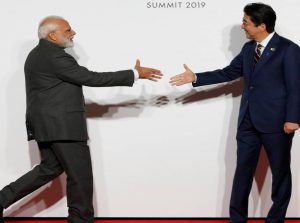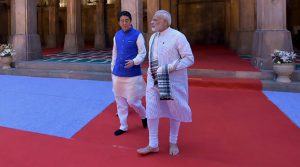“Why every home must get a newspaper”
Print journalism is in a state of crisis. The circulation of newspapers in India seems to have stagnated in relation to population growth, meaning the proportion of people reading printed news has dropped.
The relationship India shares with Japan dates back to centuries. Modi has shared special ties with Japan and his relationship goes back to his days as the Chief Minister of Gujarat. Here’s all you need to know about Indo-Japan ties.

FILE PHOTO
After a life threatening attack on ex-Japan PM Shinzo Abe, the Prime Minister Narendra Modi said he is “pained” to hear about his “dear friend” and extended his prayers to Shinzo and family. Tweet of PM Modi expressing deep distress over the attack on Abe, goes beyond just the prayers for his “dear friend” as it also describes the relationship India has shared with Shinzo Abe.
The relationship India shares with Japan dates back to centuries. Modi has shared special ties with Japan and his relationship goes back to his days as the Chief Minister of Gujarat. As PM also Modi also received Abe in 2015. Here’s all you need to know about Indo-Japan ties.
Advertisement

Indo Japan ties have a long history and the exchange between the two nations is said to have begun in the 6th century when Buddhism was introduced to Japan.
Advertisement
After World War II, in 1949, then Prime Minister of India Jawaharlal Nehru donated an Indian elephant to the Ueno Zoo in Tokyo which brought a ray of hope into the lives of the Japanese people who still had not recovered from defeat in the war. Later, India and Japan also signed a peace treaty and established diplomatic relations on 28th April, 1952.
This treaty was one of the first peace treaties Japan signed after World War II.
Prime Minister Yoshiro Mori’s visit to India in August 2000 provided the momentum to strengthen the Japan-India relationship. Mr. Mori and Prime Minister Atal Bihari Vajpayee decided the establishment of “Global Partnership between Japan and India”. Since Prime Minister Junichiro Koizumi’s visit to India in April 2005, Japan-India annual summit meetings have been held in respective capitals. When Prime Minister Manmohan Singh visited Japan in December 2006, Japan-India relationship was elevated to the “Global and Strategic Partnership”.
Modi-Abe Relationship:

In September 2014, Prime Minister Narendra Modi paid an official visit to Japan and had a summit meeting with Prime Minister Shinzo Abe. They concurred to upgrade the bilateral relationship to “Special Strategic and Global Partnership.” In December 2015, Prime Minister Abe paid an official visit to India and had a summit meeting with Mr Modi.
The two Prime Ministers resolved to transform the Japan-India Special Strategic and Global Partnership into a deep, broad-based and action-oriented partnership, which reflects a broad convergence of their long-term political, economic and strategic goals.
They announced “Japan and India Vision 2025 Special Strategic and Global Partnership Working Together for Peace and Prosperity of the Indo-Pacific Region and the World”, that came as a “new era in Japan-India relations.”

In November 2016, Prime Minister Modi paid an official visit to Japan and had a summit meeting with Prime Minister Abe. In the Japan-India Vision Statement issued during Prime Minister Modi’s visit to Japan in October 2018, two leaders reiterated their unwavering commitment to working together towards a “Free and Open Indo-Pacific”.
It is not that Modi admired Abe only after the later becoming the Prime Minister. Modi was an admirer of Abe and his policies even before he became PM. Even Abe has called Modi an ‘outstanding leader of his great country’.
As Chief Minister of Gujarat, Modi had visited Japan several times. He always made it his first stop outside India’s neighbourhood. After Modi took over as PM in 2014, India-Japan ties were upgraded to “Special Strategic and Global Partnership”. Both the countries collaborated and cooperated on a wide range of matters from civilian nuclear energy to maritime security, bullet trains to quality infrastructure, ‘Act East’ policy to Indo-Pacific strategy.
To witness the magnificent Ganga Aarti during Abe’s 3-day visit, in 2015, PM Modi and PM Abe flew together to Varanasi.
Abe’s visit to India:
In his first stint as Prime Minister in 2006-07, Abe visited India and addressed Parliament. The first time Abe visited the country as PM, he made the famous “Confluence of the Two Seas” speech which became the benchmark and foundation for Indo-pacific ties.
During his second term, Abe visited India thrice – in January 2014 on the invitation of then PM Manmohan Singh, and then twice in December 2015 and September 2017 when the relationship with PM Modi was deepened. He was courted equally by the UPA and NDA regime.
During the UPA administration, Abe was the first Japanese PM to attend India’s republic Day parade as the Chief Guest in 2014.
Advertisement